Top 6 mobile data collection apps you need to try
There was a time when collecting data on the go involved a lot of preparation, manual tasks, and sprints to places with a stable internet connection when you were in a pinch.
But that is changing as remote work becomes more common and people have access to the internet in more places.
Consider the 2017 Samsung-commissioned study that surveyed 1,205 people who spent at least a third of their day working remotely, worked at companies with at least 100 employees, and had to own a smartphone.
The study yielded a number of eyebrow-raising findings across six groups of jobs, including site workers, field service workers, drivers, public safety workers, and healthcare workers:
- Ninety-three percent used a smartphone for work every day.
- They spent close to 33 percent of their day using cell phones at work.
- The top three tasks they performed most frequently were emailing, texting, and making calls.
- They viewed or edited documents about five times a day and accessed business applications and virtual desktops with the same frequency.
- If they could use only one device at work and had to choose between a cell phone or traditional computer, 42 percent opted for their smartphone.
- Forty percent said smartphones have replaced the need for a traditional computer or will do so in a few years.
Software companies have noticed and are responding by releasing new apps every year that give mobile phones the same capabilities as traditional computers, if not more. That means remote workers can access the same products, features, and services, regardless of whether they’re working in an office or conducting fieldwork.
Offline features in mobile apps have even made it easy for people to access, view, collect, and share information anywhere, even if they can’t access the internet.
With so many options out there, how do you decide which one to use? We’ll take the guesswork out of finding the right mobile data collection app.
JotForm Mobile Forms
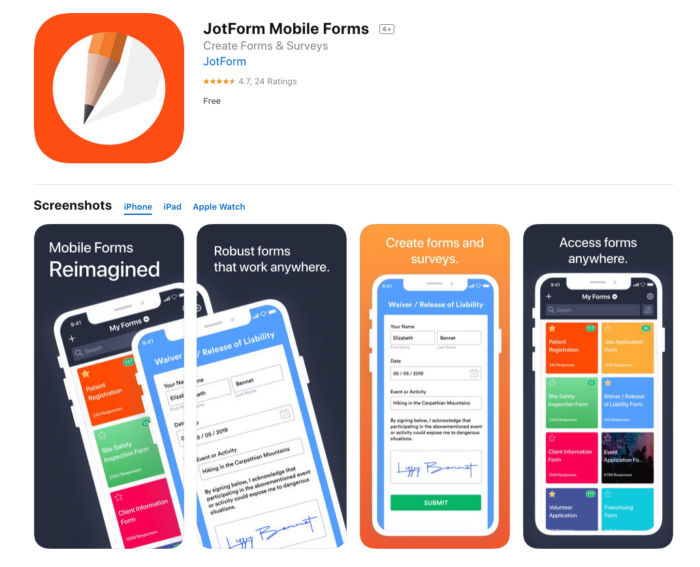
Cost: Free
Availability: Google Play store and App Store
JotForm, long known as the easiest online form builder, is making a big splash by changing the conversation around mobile forms.
The form builder’s newest app, JotForm Mobile Forms, allows users to build, view, access, sort, fill out, share, and organize all data in a single place. This eliminates the need to use several siloed solutions in order to gather information, share it, and get work done.
JotForm users can even download a PDF copy of submitted form information and add form respondents as contacts in their phone.
The mobile app contains form fields that let people scan a QR code, provide their geolocation information, record a voice message, and add their electronic signature as they fill out a form. With this information, JotForm users can not only collect more specific data but also make decisions on the fly.
The app also has an offline feature that allows users to collect the information they need when there’s limited or no connection to the internet. All the information collected offline is saved and synced to a JotForm user’s account once a stable Wi-Fi or wireless data connection is available. That means JotForm users can stop searching for a Wi-Fi connection and worrying about losing data that’s submitted when there’s no internet available.
The handy kiosk mode feature allows app users to turn their mobile device into a public survey station. Kiosk mode pulls up a form, locks it in full screen so no other applications are visible, and refreshes a form after each submission. This, in turn, creates an uninterrupted experience so different people can fill out the same form at trade shows or conventions, for instance.
JotForm users can even assign forms to team members who don’t have an account but need to access a form securely, fill it out, open it in kiosk mode, and manage their submitted information.
After you provide a teammate’s name and email address, JotForm will send that person an email with instructions to access the form. While your teammates fill out the form, you can receive notifications about incoming submissions, view the data, and act quickly on the information you receive.
JotForm Mobile Forms also makes it easy for users to share forms or individual submissions. They can send forms via text message, in an email, and through social media channels, such as WhatsApp, Facebook, and Twitter.
JotForm users with a starter, or free, plan can create up to five forms with an unlimited number of questions and receive up to 100 submissions each month. They also get up to 100 MB of space for uploaded files and can store up to 500 submissions in their account at any given time.
Smartsheet
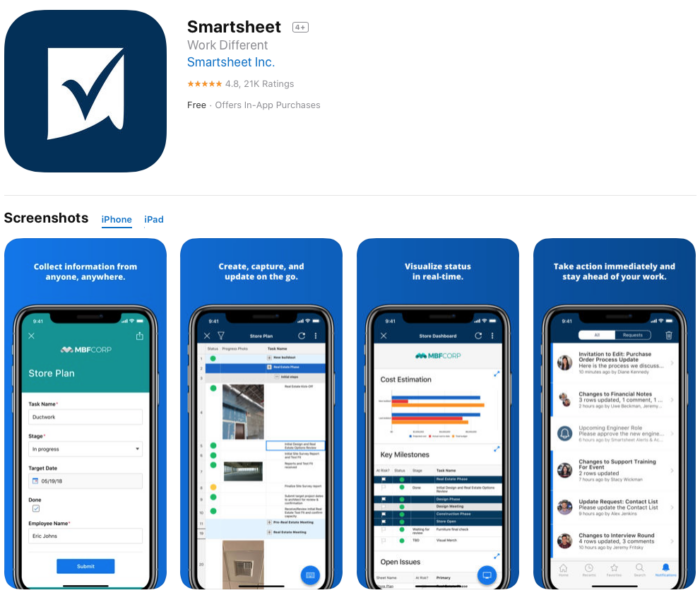
Cost: Paid subscription required after free 30-day trial
Availability: Google Play store and App Store
Smartsheet counts more than 75 percent of Fortune 500 companies as users and estimates that more than 15,000 new projects and processes are created on the interactive project management platform each day.
The broad suite of features includes data visualization tools, centralized work portals, dashboard reports, work tracking boards, and automated request or approval workflows.
Smartsheet also has a mobile app, available in eight languages, that allows registered users and team members to collaborate by accessing, viewing, editing, or updating sheets from their mobile device. Users can also sort information, respond to update requests, view project timelines, make decisions on relayed approvals, and pull up reports on key metrics that are updated in real time.
The mobile app allows users and licensed collaborators to access and fill out a form attached to a sheet. Form responders can even scan a barcode, share location information, or upload files, including photos taken from their mobile device. Once a form is submitted, this information is used to populate rows in an associated sheet.
According to Smartsheet, collecting data with forms is particularly helpful for employees, such as field inspectors, who travel or work from a number of sites and need to access information.
A paid subscription is required to use Smartsheet’s features and its mobile app after a free 30-day trial period. Once the trial period is over, any content created during that time can be viewed for 90 days. This data will be deleted if you don’t sign up for a subscription during the 90-day window.
Smartsheet forms must be built on a desktop before they can be shared with licensed collaborators or sent in a link.
Device Magic
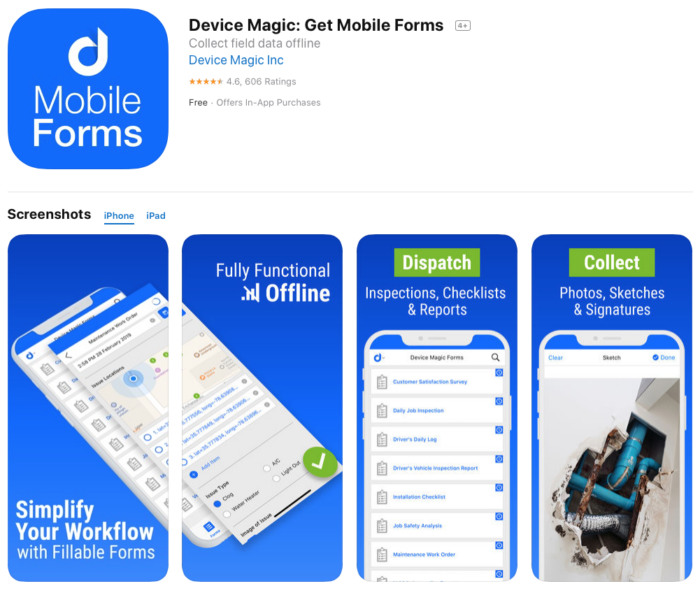
Cost: Free
Availability: Google Play store and App Store
Device Magic helps workers collect and share information on the go.
To get started, Device Magic users build forms on their laptops or desktops. A drag-and-drop tool allows them to select questions from a toolbar, place them on a blank workspace, and rearrange the order of questions.
Team members added to a company’s Device Magic account can access forms through the app on their mobile devices. Permissions settings give users the flexibility to determine which devices or fellow users can access a form. Users can add devices to a Device Magic account by sending a text or email invitation to new team members.
Device Magic also has offline capabilities, so users don’t need an internet connection to access, fill out, and submit forms through the app. In these cases, submitted form information is saved on a mobile device and transmitted once an internet connection has been reestablished.
There are several advanced form fields, or questions, that allow team members to collect an electronic signature, scan a barcode, attach files, include a photo, and submit annotations to an uploaded image.
Enterprise users can even use Device Magic’s Dispatch feature to have designated team members complete forms with prepopulated information or send a completed form to specific people once it has been submitted.
This workflow can come in handy when remote workers need to share important information —such as job quotes, invoices, purchase orders, or inspection reports — and quickly get approval from managers.
Device Magic offers a 14-day free trial of its Enterprise plan, after which users can sign up for a paid plan to access many key features. Users who do not upgrade after the trial period will be downgraded to a free account.
There are no limits on the number of forms users with free accounts can create or the number of submissions they can receive. However, they can only connect one device per account, which means that they cannot assign or share forms across devices until they upgrade to a paid plan.
Zoho Forms
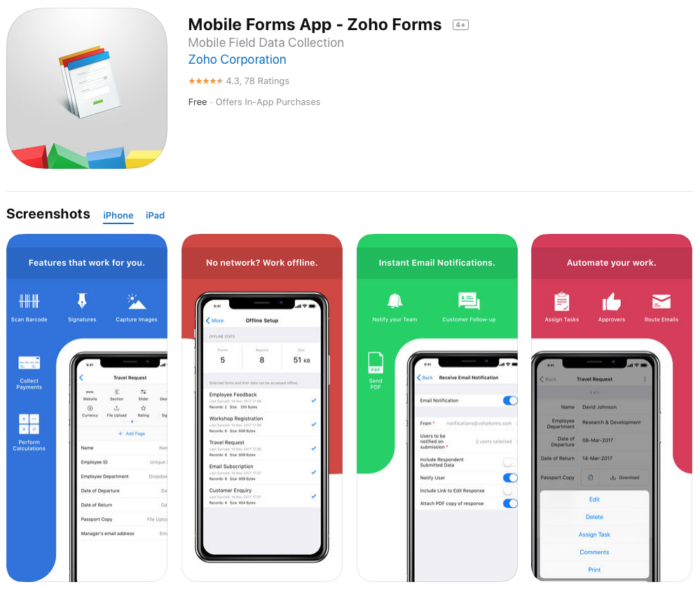
Cost: Free
Availability: Google Play store and App Store
With Zoho Forms, registered users can build customizable forms, collect a broad range of information across devices, and manage where that data goes and how it’s used.
That same range of functionality extends to the Zoho Forms app, which allows registered users to build forms from scratch or get a jumpstart on the process by using dozens of templates. Themes used to design a form, however, don’t appear in the app, and users must have a paid plan to customize the design of their form.
The form builder offers a wide range of form fields and many types of questions, so users have more control over what data they collect and how they ask for that information. The electronic signature field, for example, allows people to sign a form on any device with a finger, stylus, trackpad, or mouse.
Users can also modify the properties of individual questions, so they can determine how information is gathered and how questions will appear on a form.
For instance, users can enable form respondents to scan barcodes, QR codes, and business cards with the camera on their mobile device. That data is then used to fill in specific information on a form, such as names, addresses, email addresses, phone numbers, product tags, or offer codes.
As another example, activating the app’s geolocation feature for a specific form allows users to determine where someone filled out and submitted information.
The Zoho Forms app allows users to publish their form on a website, share it on social media, or distribute it as a QR code or public URL. Forms, as well as any submitted form information, can be shared as tasks with other coworkers on the Zoho Forms account.
The kiosk mode feature allows a form to be displayed in full-screen view within the Zoho Forms app. Multiple people can fill out a form on the mobile device but can’t access other parts of the app, such as submitted information or other forms. Users just set a passcode to ensure form respondents don’t gain full access to the app, and then use that passcode to close kiosk mode.
The app allows users to append comments to forms for additional follow-up or background information.
The Zoho Forms app also works offline, so users don’t need an internet connection to build forms, fill them out, and submit information. The data is saved and will be transmitted or uploaded once a mobile device is reconnected to the internet.
Users on free plans can create up to three forms, receive up to 500 submissions a month, upload up to 200 MB of files, and collect up to 10 payments through their forms using Zoho’s integrations with payment processors, including Stripe and PayPal. With a basic plan, at $8 per month, users may receive up to 10,000 submissions each month and store up to 500 MB of files.
Fulcrum
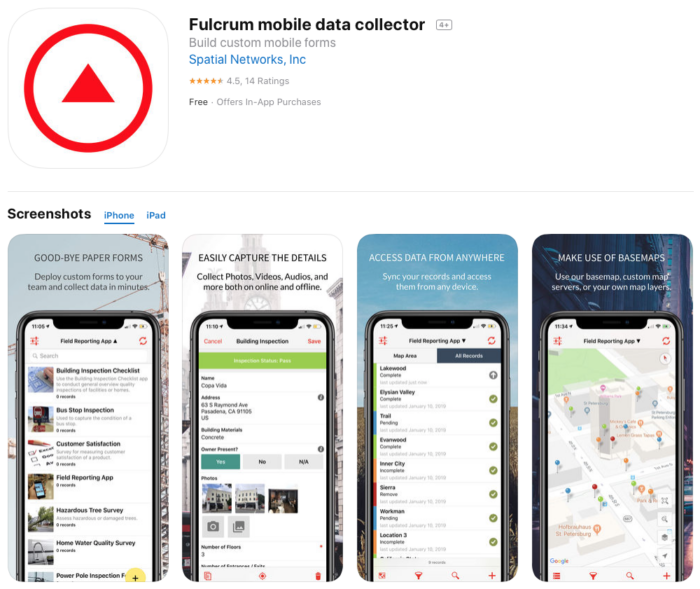
Cost: Paid subscription required after free 14-day trial
Availability: Google Play store and App Store
Spatial Networks, which leverages geospatial data to develop innovative solutions, launched Fulcrum for companies that rely on field-workers to collect and share information.
More than 110,000 users in 180 countries have used the data collection tool to collect upwards of 174 million records and add more than 55 million geotags to uploaded photos.
Fulcrum users must build a form on their desktop or laptop. They can either use a form builder to drag and drop the questions that they want to ask onto a blank space or select from a variety of templates by industry, such as agriculture, archaeology, business services, construction, environmental services, and emergency management.
After a form has been created, it’s synced automatically to a user’s account and the Fulcrum app. Forms can be assigned to designated team members who can then fill in information, upload photos, capture electronic signatures, and scan barcodes or QR codes. Form respondents can also share geotagged photos with annotations, videos, and audio files that can be viewed on a mobile device, desktop, or laptop.
Because these uploaded files contain geographic and location data, users can track this information on different types of maps offered by Fulcrum or other offline sources, such as Google Street or OpenStreetMap.
Fulcrum’s offline capabilities allow users to view forms, fill them out, and submit information even when a stable internet connection isn’t available. The data is stored on a form respondent’s mobile device and transmitted once a cell phone signal or Wi-Fi connection is found.
During the 14-day free trial of Fulcrum’s services and app, businesses can add up to 50 users to a single plan, export up to 100 records, create no more than three public URLs to share data, and store up to 3 GB of media files.
Once the trial period is over, users can choose to upgrade to a paid plan, starting at $28 per user/month, or $22 per user/month when billed annually.
Magpi+
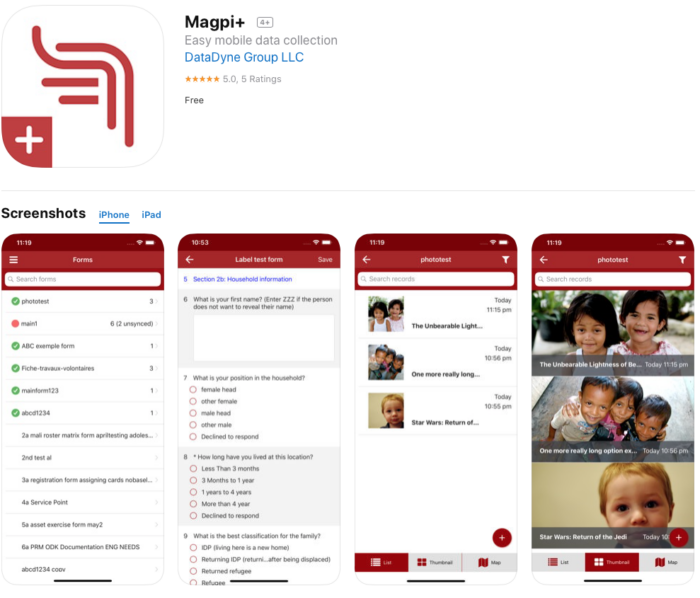
Cost: Free
Availability: Google Play store and App Store
Magpi’s mobile app, Magpi+, seeks to help nonprofits and nongovernmental organizations lower data collection costs that were traditionally spent on programmers and tech consultants.
Magpi users include well-known nonprofits, heath organizations, and academic institutions, including UNICEF, Mercy Corps, the World Bank, and The Centers for Disease Control and Prevention.
Before forms can be deployed on mobile devices, Magpi users must build them on a web browser from their desktop or laptop. After logging into their Magpi account, users select the form fields that they’d like to use before formatting them and writing the desired text for all questions.
Users must have a paid plan to allow form responders to scan barcodes and QR codes, or draw their electronic signature or a sketch.
Magpi also allows users to create and fill out forms using a wide variety of languages and alphabets as long as their computers are configured properly and can read the information.
Once Magpi users create their forms, they can assign them to team members who have access to the account and the Magpi+ app downloaded on their mobile devices.
The app not only lets these team members access, fill out, and submit forms but also allows them to view submitted information as an ordered list, thumbnails based on shared images, or a map based on any geolocation data provided. Since any submitted form information is updated automatically in Magpi, teams can access this data regardless of whether they’re using a laptop, desktop, or mobile device to access their account.
Since Magpi was developed for field-workers, the Magpi+ app has offline capabilities that allow teams to collect and submit information in areas that have little or no access to the internet. In these cases, submitted form information is saved on a device and transmitted once a stable internet connection is established.
Magpi users with a free plan can create up to 20 forms, include up to 100 questions on a form, receive up to 500 submissions a month, and add up to 15 people to an account.
Conclusion
JotForm Mobile Forms stands out in the crowd as an all-in-one, end-to-end solution.
For starters, JotForm Mobile Forms allows you to build customized forms on your mobile device while you’re connected to the internet and need to work on the go. You can also give your forms a professional and polished touch on your smartphone or tablet.
This means you no longer have to fret over siloed solutions that require you to build a form on your desktop or laptop before accessing it on a mobile device.
Assigning forms to teammates and tracking their actions can be frustrating in many mobile data collection apps because you must either add them to your account or upgrade from a free plan.
With JotForm Mobile Forms, you can assign forms to colleagues who don’t have a JotForm account, even if you have a free, starter plan.
Some software companies will let you test out a mobile data collection app for a while but require you to buy a subscription once your trial period is over.
JotForm Mobile Forms, however, is free to use for anyone who has a JotForm account, even if you have a free, starter plan. There isn’t even a limit on the features that you can use for free, including the option to scan QR codes or collect electronic signatures. There’s no strings attached or fine print to read, so what you see is what you get.
So, what are you waiting for?
Give JotForm Mobile Forms a try today and see how the mobile data collection app is redefining the way people think about forms.

